Application of MOS Gas Sensors Coupled with Chemometrics Methods to Predict the Amount of Sugar and Carbohydrates in Potatoes
Abstract
:1. Introduction
2. Materials and Methods
2.1. Sample Preparation
2.2. Electronic Nose Instrument
2.2.1. Sampling
2.2.2. Pattern Recognition System
2.3. Sugar and Carbohydrate Extraction
2.4. Determination of Toughness
2.5. Statistical Analysis
2.5.1. Analysis of Variance
2.5.2. Chemometric Analysis
2.6. Model Performance
3. Results and Discussion
3.1. Sugar and Carbohydrate Content of Potato Varieties
3.2. Response Sensors
3.3. Prediction of Quality Parameters of Carbohydrate and Sugar Based on PLSR and PCR
3.4. Prediction of Quality Parameters of Carbohydrate, Sugar and Toughness Based on MLR
3.5. Support Vector Machine (SVM)
4. Discussion
5. Conclusions
Author Contributions
Funding
Institutional Review Board Statement
Informed Consent Statement
Data Availability Statement
Acknowledgments
Conflicts of Interest
References
- Navarre, D.A.; Goyer, A.; Shakya, R. Chapter 14—Nutritional Value of Potatoes: Vitamin, Phytonutrient, and Mineral Content. In Advances in Potato Chemistry and Technology; Singh, J., Kaur, L., Eds.; Academic Press: San Diego, CA, USA, 2009; pp. 395–424. [Google Scholar]
- Kaur, L.; Singh, N.; Sodhi, N.S. Some properties of potatoes and their starches II. Morphological, thermal and rheological properties of starches. Food Chem. 2002, 79, 183–192. [Google Scholar] [CrossRef]
- Khatami, A.; Alebrahim, M.T.; Mohebodini, M.; Majd, R. Evaluating Rimsulforon Efficiency on Controlling Weeds in Potato at Different Growth Stages. J. Plant Prot. 2017, 31, 152–165. [Google Scholar]
- Khorramifar, A.; Rasekh, M.; Karami, H.; Malaga-Toboła, U.; Gancarz, M. A Machine Learning Method for Classification and Identification of Potato Cultivars Based on the Reaction of MOS Type Sensor-Array. Sensors 2021, 21, 5836. [Google Scholar] [CrossRef]
- Kedia, P.; Kausley, S.B.; Rai, B. Development of kinetic models for prediction of reducing sugar content in potatoes using literature data on multiple potato varieties. LWT 2022, 155, 112986. [Google Scholar] [CrossRef]
- Tai, H.H.; Lagüe, M.; Thomson, S.; Aurousseau, F.; Neilson, J.; Murphy, A.; Bizimungu, B.; Davidson, C.; Deveaux, V.; Bègue, Y.; et al. Tuber transcriptome profiling of eight potato cultivars with different cold-induced sweetening responses to cold storage. Plant Physiol. Biochem. 2020, 146, 163–176. [Google Scholar] [CrossRef] [PubMed]
- Rady, A.M.; Guyer, D.E. Evaluation of sugar content in potatoes using NIR reflectance and wavelength selection techniques. Postharvest Biol. Technol. 2015, 103, 17–26. [Google Scholar] [CrossRef]
- Bataller, B.G.; Capareda, S.C. A rapid and non-destructive method for quantifying biomolecules in Spirulina platensis via Fourier transform infrared—Attenuated total reflectance spectroscopy. Algal Res. 2018, 32, 341–352. [Google Scholar] [CrossRef]
- Lu, H.; Ference, C.; Zhang, Q. Visible/near Infrared Reflection Spectrometer and Electronic Nose Data Fusion as an Accuracy Improvement Method for Portable Total Soluble Solid Content Detection of Orange. Appl. Sci. 2019, 9, 3761. [Google Scholar]
- Zhang, H.; Chang, M.; Wang, J.; Ye, S. Evaluation of peach quality indices using an electronic nose by MLR, QPST and BP network. Sens. Actuators B. Chem. 2008, 134, 332–338. [Google Scholar] [CrossRef]
- Kiani, S.; Minaei, S.; Ghasemi-Varnamkhasti, M. Real-time aroma monitoring of mint (Mentha spicata L.) leaves during the drying process using electronic nose system. Measurement 2018, 124, 447–452. [Google Scholar] [CrossRef]
- Zhou, C.; Fan, J.; Tan, R.; Peng, Q.; Cai, J.; Zhang, W. Prediction of Linalool Content in Osmanthus fragrans Using E-Nose Technology. J. Sens. 2022, 2022, 7349030. [Google Scholar] [CrossRef]
- Wei, Z.; Wang, J.; Zhang, W. Detecting internal quality of peanuts during storage using electronic nose responses combined with physicochemical methods. Food Chem. 2015, 177, 89–96. [Google Scholar] [CrossRef] [PubMed]
- Karami, H.; Rasekh, M.; Mirzaee-Ghaleh, E. Comparison of chemometrics and AOCS official methods for predicting the shelf life of edible oil. Chemom. Intell. Lab. Syst. 2020, 206, 104165. [Google Scholar] [CrossRef]
- Karami, H.; Rasekh, M.; Mirzaee-Ghaleh, E. Qualitative analysis of edible oil oxidation using an olfactory machine. J. Food Meas. Charact. 2020, 14, 2600–2610. [Google Scholar] [CrossRef]
- Rasekh, M.; Karami, H.; Wilson, A.D.; Gancarz, M. Performance Analysis of MAU-9 Electronic-Nose MOS Sensor Array Components and ANN Classification Methods for Discrimination of Herb and Fruit Essential Oils. Chemosensors 2021, 9, 243. [Google Scholar] [CrossRef]
- Karami, H.; Rasekh, M.; Mirzaee-Ghaleh, E. Application of the E-nose machine system to detect adulterations in mixed edible oils using chemometrics methods. J. Food Process. Preserv. 2020, 44, e14696. [Google Scholar] [CrossRef]
- Karami, H.; Rasekh, M.; Mirzaee-Ghaleh, E. Identification of olfactory characteristics of edible oil during storage period using of MOS sensors signal and ANN methods. J. Food Process. Preserv. 2021, 45, e15749. [Google Scholar] [CrossRef]
- Szulczyński, B.; Gębicki, J.; Namieśnik, J. Monitoring and efficiency assessment of biofilter air deodorization using electronic nose prototype. Chem. Pap. 2018, 72, 527–532. [Google Scholar] [CrossRef]
- Ikanone, C.E.O.; Oyekan, P.O. Effect of Boiling and Frying on the Total Carbohydrate, Vitamin C and Mineral Contents of Irish (Solanun tuberosum) and Sweet (Ipomea batatas) Potato Tubers. Niger. Food J. 2014, 32, 33–39. [Google Scholar] [CrossRef] [Green Version]
- Sanaeifar, A.; Mohtasebi, S.S.; Ghasemi-Varnamkhasti, M.; Ahmadi, H. Application of MOS based electronic nose for the prediction of banana quality properties. Measurement 2016, 82, 105–114. [Google Scholar] [CrossRef]
- Abbaszadeh, R.; Rajabipour, A.; Ahmadi, H.; Mahjoob, M.J.; Delshad, M. Prediction of watermelon quality based on vibration spectrum. Postharvest Biol. Technol. 2013, 86, 291–293. [Google Scholar] [CrossRef]
- Hung, T.; Lee, K.; Le, N.; Tuan, L.; Nguyen, T.; Thi, C.; Kang, J.-H. An AI-based Prediction Model for Drug--drug Interactions in Osteoporosis and Paget’s Diseases from SMILES. Mol. Inform. 2022. [Google Scholar] [CrossRef] [PubMed]
- Stark, J.C.; Love, S.L.; Knowles, N.R. Tuber Quality. In Potato Production Systems; Stark, J.C., Thornton, M., Nolte, P., Eds.; Springer International Publishing: Cham, Switzerland, 2020; pp. 479–497. [Google Scholar]
- Gumul, D.; Ziobro, R.; Noga, M.; Sabat, R. Characterisation of five potato cultivars according to their nutritional and pro-health components. Acta Sci. Polonorum. Technol. Aliment. 2011, 10, 77–81. [Google Scholar]
- Rasekh, M.; Karami, H. E-nose coupled with an artificial neural network to detection of fraud in pure and industrial fruit juices. Int. J. Food Prop. 2021, 24, 592–602. [Google Scholar] [CrossRef]
- Ran, X.-L.; Zhang, M.; Wang, Y.; Liu, Y. A comparative study of three drying methods on drying time and physicochemical properties of chicken powder. Dry. Technol. 2019, 37, 373–386. [Google Scholar] [CrossRef]
- Wang, R.; Huang, F.; Zhang, L.; Liu, Q.; Zhang, C.; Zhang, H. Changes in the texture, microstructures, colour and volatile compounds of pork meat loins during superheated steam cooking. Int. J. Food Sci. Technol. 2019, 54, 2821–2830. [Google Scholar] [CrossRef]
- Huang, X.-H.; Fu, B.-S.; Qi, L.-B.; Huo, L.-D.; Zhang, Y.-Y.; Du, M.; Dong, X.-P.; Zhu, B.-W.; Qin, L. Formation and conversion of characteristic volatile compounds in grilled eel (Astroconger myriaster) during different processing steps. Food Funct. 2019, 10, 6473–6483. [Google Scholar] [CrossRef]
- Abu-Khalaf, N. Identification and Quantification of Olive Oil Quality Parameters Using an Electronic Nose. Agriculture 2021, 11, 674. [Google Scholar] [CrossRef]
- Zhang, X.; Li, M.; Cheng, Z.; Ma, L.; Zhao, L.; Li, J. A comparison of electronic nose and gas chromatography–mass spectrometry on discrimination and prediction of ochratoxin A content in Aspergillus carbonarius cultured grape-based medium. Food Chem. 2019, 297, 124850. [Google Scholar] [CrossRef]
- Zaki Dizaji, H.; Adibzadeh, A.; Aghili Nategh, N. Application of E-nose technique to predict sugarcane syrup quality based on purity and refined sugar percentage. J. Food Sci. Technol. 2021, 58, 4149–4156. [Google Scholar] [CrossRef]
- Gu, S.; Wang, Z.; Chen, W.; Wang, J. Early identification of Aspergillus spp. contamination in milled rice by E-nose combined with chemometrics. J. Sci. Food Agric. 2021, 101, 4220–4228. [Google Scholar] [CrossRef] [PubMed]
- Du, D.; Xu, M.; Wang, J.; Gu, S.; Zhu, L.; Hong, X. Tracing internal quality and aroma of a red-fleshed kiwifruit during ripening by means of GC-MS and E-nose. RSC Adv. 2019, 9, 21164–21174. [Google Scholar] [CrossRef] [PubMed] [Green Version]
- Xu, M.; Wang, J.; Zhu, L. The qualitative and quantitative assessment of tea quality based on E-nose, E-tongue and E-eye combined with chemometrics. Food Chem. 2019, 289, 482–489. [Google Scholar] [CrossRef] [PubMed]
- Zhang, D.; Ji, W.; Peng, Y.; Ji, H.; Gao, J. Evaluation of Flavor Improvement in Antarctic Krill Defluoridated Hydrolysate by Maillard Reaction Using Sensory Analysis, E.-nose, and GC-MS. J. Aquat. Food Prod. Technol. 2020, 29, 279–292. [Google Scholar] [CrossRef]
- Du, D.; Wang, J.; Wang, B.; Zhu, L.; Hong, X. Ripeness Prediction of Postharvest Kiwifruit Using a MOS E-Nose Combined with Chemometrics. Sensors 2019, 19, 419. [Google Scholar] [CrossRef] [Green Version]
- Gu, S.; Chen, W.; Wang, Z.; Wang, J.; Huo, Y. Rapid detection of Aspergillus spp. infection levels on milled rice by headspace-gas chromatography ion-mobility spectrometry (HS-GC-IMS) and E-nose. LWT 2020, 132, 109758. [Google Scholar] [CrossRef]
- Tian, X.; Long, M.; Liu, Y.; Zhang, P.; Bai, X.; Wang, J.; Wei, Z.; Chen, S.; Ma, Z.; Song, L.; et al. Effect of Storage Time and Packing Method on the Freshness of Dried Lycium Fruit Using Electronic Nose and Chemometrics. J. Food Qual. 2020, 2020, 6145189. [Google Scholar] [CrossRef] [Green Version]
- Mishra, G.; Srivastava, S.; Panda, B.K.; Mishra, H.N. Prediction of Sitophilus granarius infestation in stored wheat grain using multivariate chemometrics & fuzzy logic-based electronic nose analysis. Comput. Electron. Agric. 2018, 152, 324–332. [Google Scholar]
- Sun, Y.; Wang, J.; Cheng, S. Early Diagnosis of Botrytis Cinerea Infestation of Tomato Plant by Electronic Nose. Appl. Eng. Agric. 2018, 34, 667–674. [Google Scholar] [CrossRef]
- Tian, X.; Wang, J.; Ma, Z.; Li, M.; Wei, Z. Combination of an E-Nose and an E-Tongue for Adulteration Detection of Minced Mutton Mixed with Pork. J. Food Qual. 2019, 2019, 4342509. [Google Scholar] [CrossRef] [Green Version]
- Srivastava, S.; Mishra, G.; Mishra, H.N. Fuzzy controller based E-nose classification of Sitophilus oryzae infestation in stored rice grain. Food Chem. 2019, 283, 604–610. [Google Scholar] [CrossRef] [PubMed]
- Khorramifar, A.; Karami, H.; Wilson, A.D.; Sayyah, A.H.A.; Shuba, A.; Lozano, J. Grape Cultivar Identification and Classification by Machine Olfaction Analysis of Leaf Volatiles. Chemosensors 2022, 10, 125. [Google Scholar] [CrossRef]
- Rasekh, M.; Karami, H. Application of electronic nose with chemometrics methods to the detection of juices fraud. J. Food Process. Preserv. 2021, 45, e15432. [Google Scholar] [CrossRef]
- Gancarz, M.; Dobrzański, B.; Malaga-Toboła, U.; Tabor, S.; Combrzyński, M.; Ćwikła, D.; Strobel, W.R.; Oniszczuk, A.; Karami, H.; Darvishi, Y.; et al. Impact of Coffee Bean Roasting on the Content of Pyridines Determined by Analysis of Volatile Organic Compounds. Molecules 2022, 27, 1559. [Google Scholar] [CrossRef]
- Alimohammadi, F.; Rasekh, M.; Afkari Sayyah, A.H.; Abbaspour-Gilandeh, Y.; Karami, H.; Rasooli Sharabiani, V.; Fioravanti, A.; Gancarz, M.; Findura, P.; Kwaśniewski, D. Hyperspectral imaging coupled with multivariate analysis and artificial intelligence to the classification of maize kernels. Int. Agrophysics 2022, 36, 83–91. [Google Scholar] [CrossRef]
- Tatli, S.; Mirzaee-Ghaleh, E.; Rabbani, H.; Karami, H.; Wilson, A.D. Rapid Detection of Urea Fertilizer Effects on VOC Emissions from Cucumber Fruits Using a MOS E-Nose Sensor Array. Agronomy 2022, 12, 35. [Google Scholar] [CrossRef]
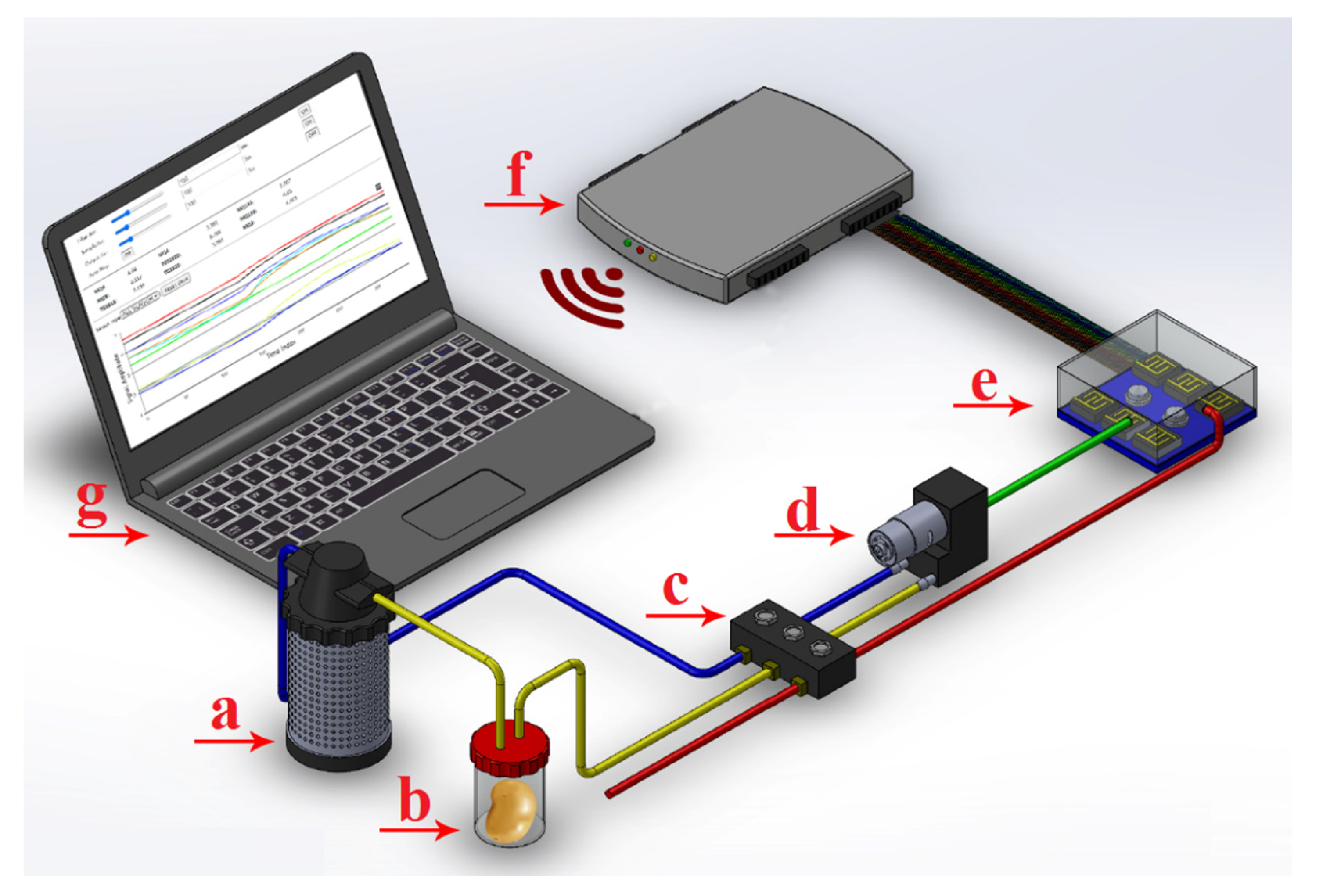

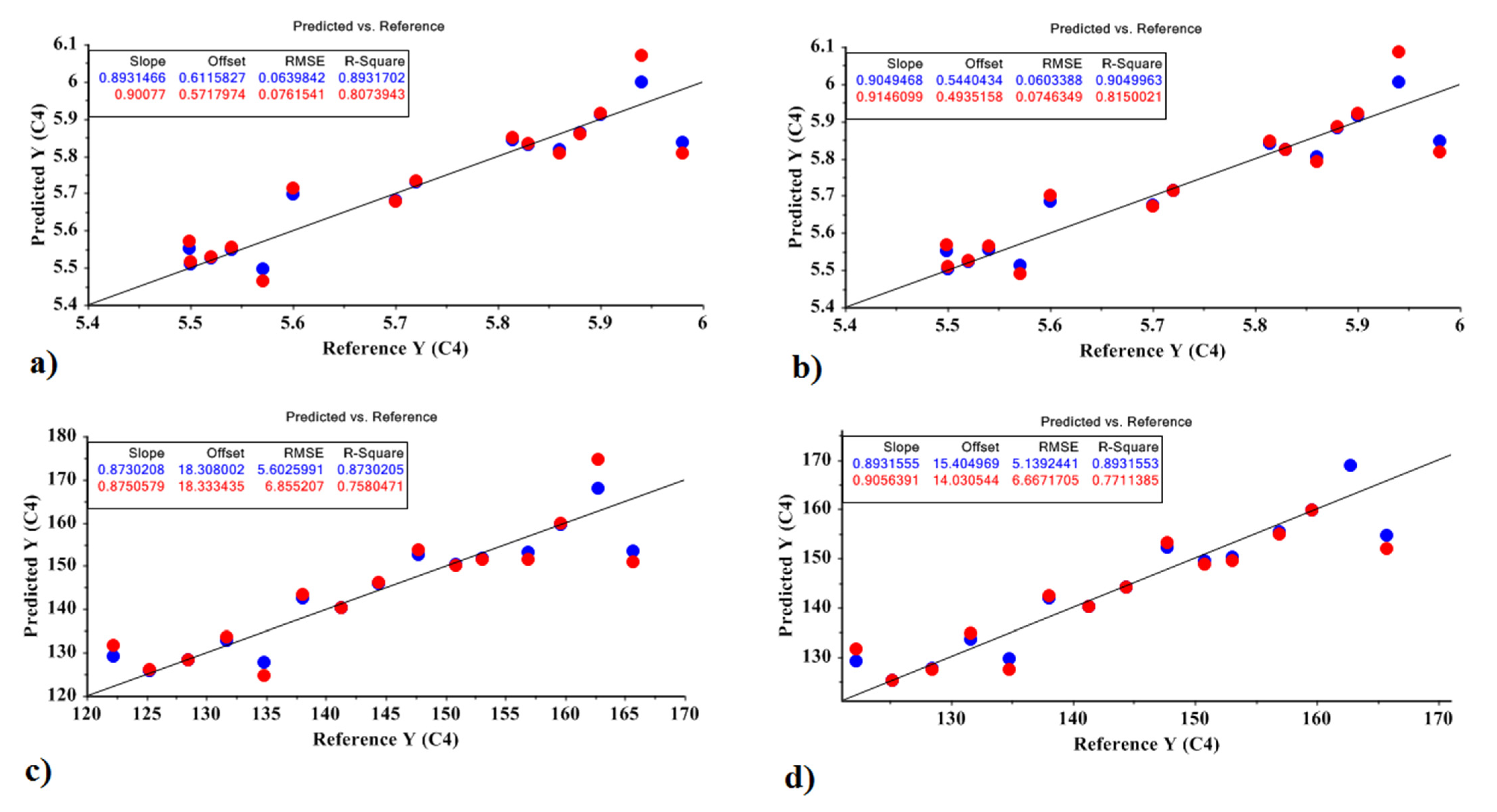
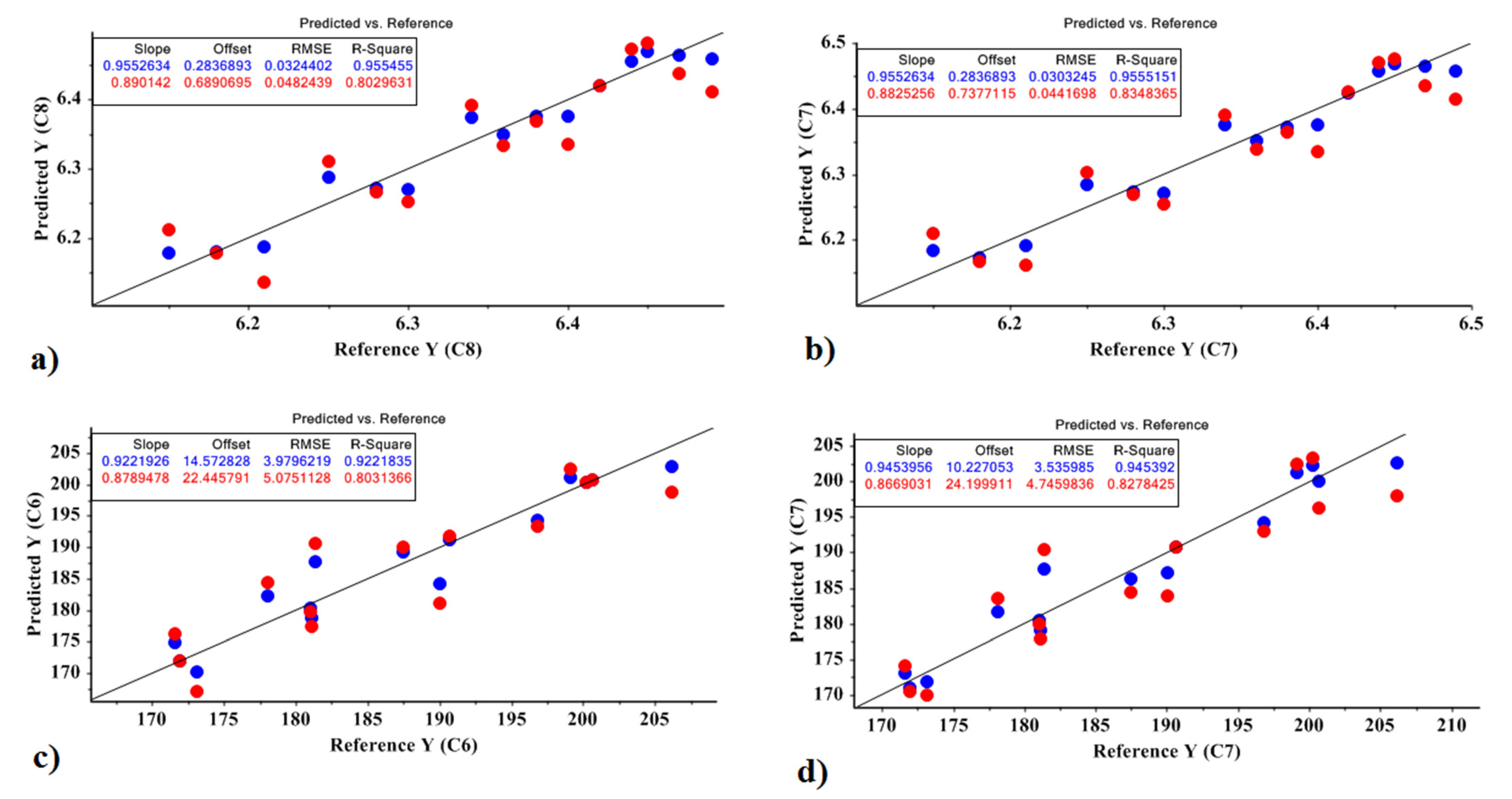
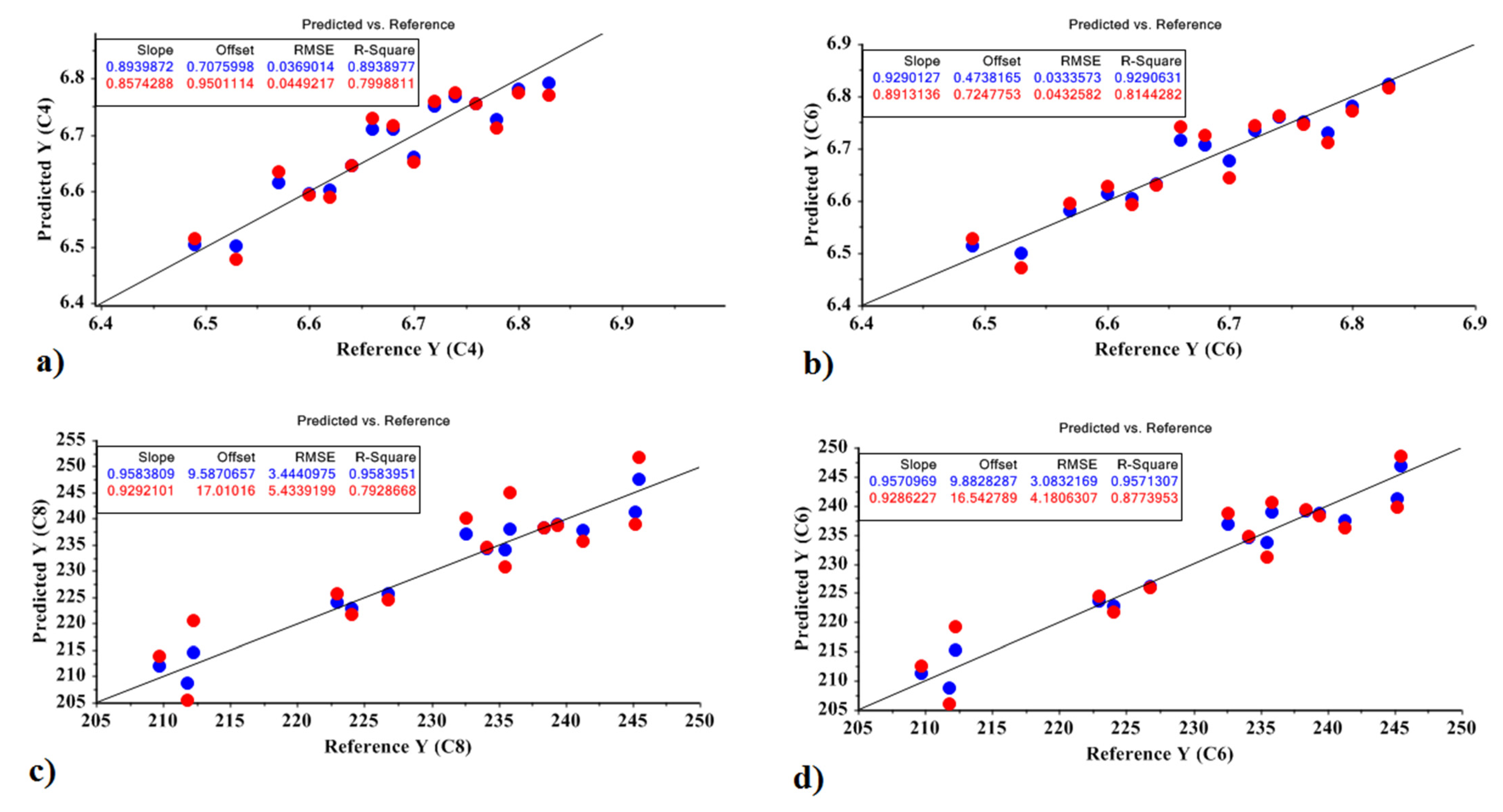

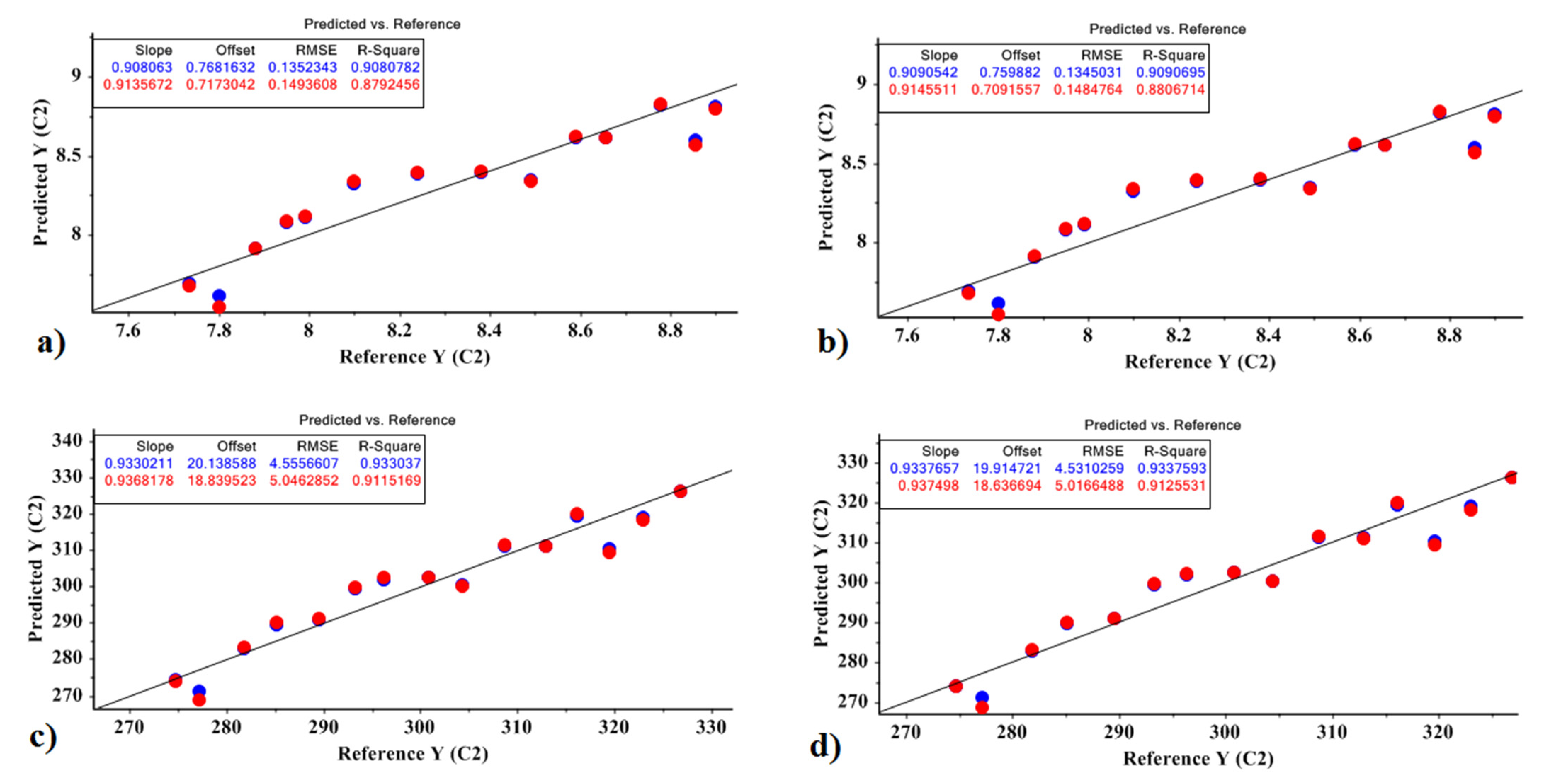
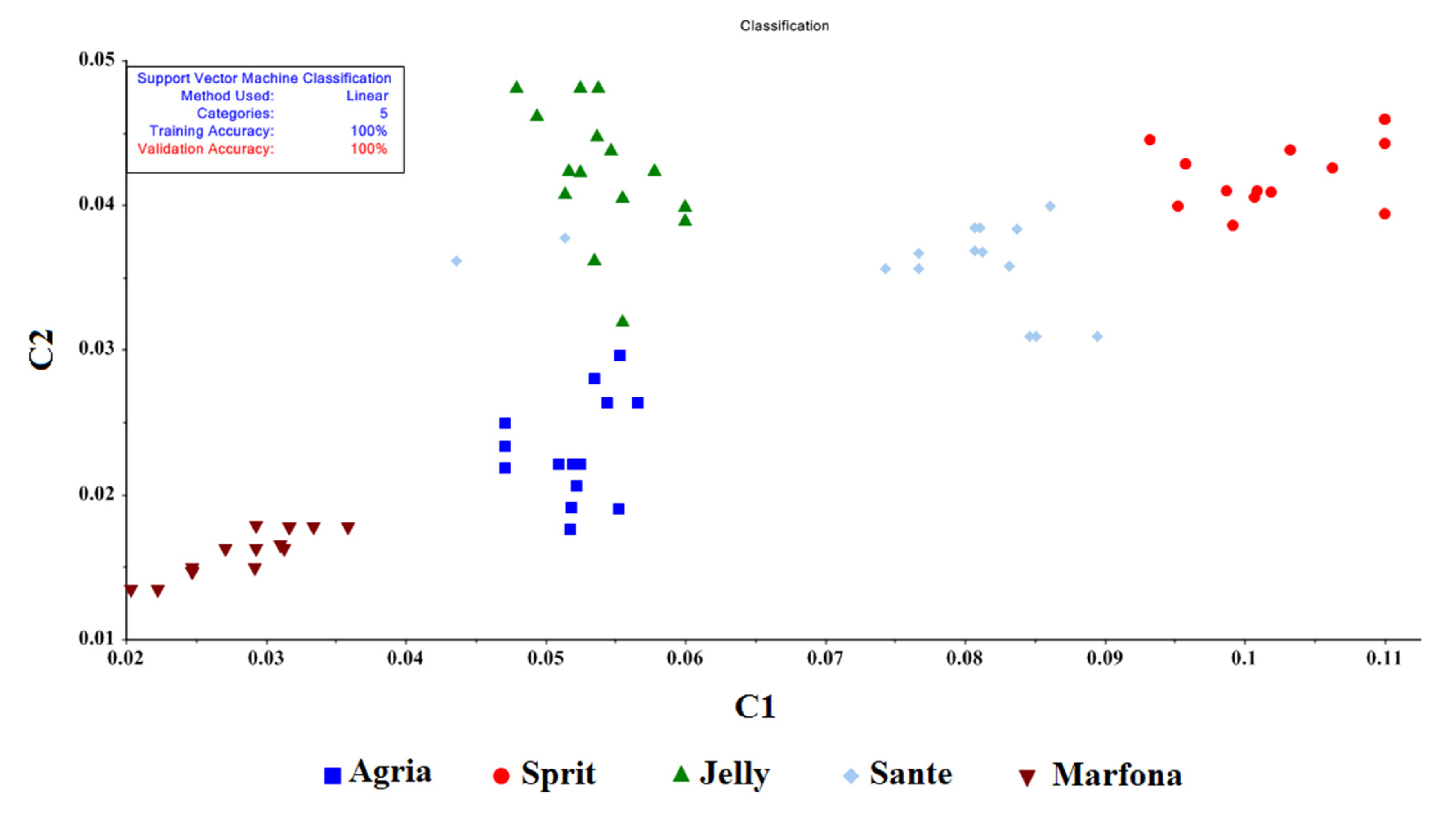
| Sources | Degrees of Freedom | Mean of Squares |
|---|---|---|
| Sugar | 4 | 2.198 ** |
| Error | 10 | 0.0003 |
| Total | 14 | |
| Carbohydrate | 4 | 8184.567 ** |
| Error | 10 | 294.23 |
| Total | 14 | |
| Cultivar (C) | 4 | 0.002 ** |
| Loading speed (V) | 2 | 0.001 ** |
| C*V | 8 | 0.000 ** |
| Error | 90 | 0.000 |
| Total | 104 |
| Sprit | Agria | Jelly | Sante | Marfona | |
|---|---|---|---|---|---|
| Sugar | 8.153 a | 6.183 d | 6.117 e | 7.203 b | 6.493 c |
| Carbohydrate | 266 a | 179 b | 237 a | 276.7 a | 159.3 b |
| Toughness (V1) | 0.103 e | 0.109 d | 0.117 c | 0.126 b | 0.135 a |
| Toughness (V2) | 0.1 e,f | 0.097 f | 0.113 c,d | 0.11 d | 0.117 c |
| Toughness (V3) | 0.099 e,f | 0.097 f | 0.113 c,d | 0.108 d | 0.117 c |
| Cultivars | Chemical Parametrs | Model | R2cal | R2val | RMSEcal | RMSEval | Offsetcal | Offsetval | Optimal Factor |
|---|---|---|---|---|---|---|---|---|---|
| Sprite | Carbohydrate | PCR | 0.877 | 0.837 | 4.802 | 5.937 | 17.636 | 33.347 | 3 |
| PLSR | 0.898 | 0.799 | 4.380 | 6.596 | 14.672 | 16.599 | 3 | ||
| Sugar | PCR | 0.893 | 0.866 | 0.054 | 0.065 | 0.611 | 1.077 | 3 | |
| PLSR | 0.904 | 0.826 | 0.051 | 0.074 | 0.543 | 0.582 | 3 | ||
| Agria | Carbohydrate | PCR | 0.922 | 0.799 | 3.082 | 5.295 | 14.574 | 33.939 | 5 |
| PLSR | 0.945 | 0.813 | 2.582 | 5.117 | 10.227 | 23.829 | 6 | ||
| Sugar | PCR | 0.955 | 0.831 | 0.022 | 0.046 | 0.282 | 0.756 | 7 | |
| PLSR | 0955 | 0.820 | 0.022 | 0.047 | 0.282 | 0.834 | 6 | ||
| Jelly | Carbohydrate | PCR | 0.958 | 0.823 | 2.352 | 5.187 | 9.583 | 18.859 | 7 |
| PLSR | 0.957 | 0.814 | 2.388 | 5.317 | 9.847 | 27.443 | 5 | ||
| Sugar | PCR | 0.893 | 0.819 | 0.031 | 0.044 | 0.708 | 1.584 | 3 | |
| PLSR | 0.929 | 0.772 | 0.025 | 0.049 | 0.473 | 1.026 | 5 | ||
| Sante | Carbohydrate | PCR | 0.921 | 0.872 | 2.177 | 2.963 | 20.254 | 3.885 | 4 |
| PLSR | 0.910 | 0.848 | 2.322 | 3.232 | 23.040 | 46.55 | 2 | ||
| Sugar | PCR | 0.906 | 0.874 | 0.059 | 0.074 | 0.674 | 0.992 | 4 | |
| PLSR | 0.900 | 0.859 | 0.061 | 0.078 | 0.720 | 1.062 | 2 | ||
| Marfona | Carbohydrate | PCR | 0.933 | 0.923 | 4.241 | 4.859 | 20.133 | 21.208 | 1 |
| PLSR | 0.933 | 0.923 | 4.218 | 4.859 | 19.916 | 21.046 | 1 | ||
| Sugar | PCR | 0.908 | 0.895 | 0.125 | 0.143 | 0.768 | 0.781 | 1 | |
| PLSR | 0.909 | 0.895 | 0.125 | 0.143 | 0.759 | 0.775 | 1 |
| Kernel Function | C-SVM 1 | Nu-SVM 1 | ||||||
|---|---|---|---|---|---|---|---|---|
| c | γ | Train | Validation | Nu | γ | Train | Validation | |
| linear | 0.1 | 1 | 100 | 100 | 1 | 0.99 | 93.33 | 98.67 |
| Polynomial | 0.01 | 1 | 94.67 | 94.67 | 0.01 | 0.25 | 97.33 | 98.66 |
| Radial basis function | 0.01 | 0.1 | 100 | 98.67 | 0.255 | 1 | 97.33 | 96.00 |
| sigmoid | 0.01 | 0.1 | 100 | 98.66 | 0.01 | 1 | 98.67 | 94.67 |
Publisher’s Note: MDPI stays neutral with regard to jurisdictional claims in published maps and institutional affiliations. |
© 2022 by the authors. Licensee MDPI, Basel, Switzerland. This article is an open access article distributed under the terms and conditions of the Creative Commons Attribution (CC BY) license (https://creativecommons.org/licenses/by/4.0/).
Share and Cite
Khorramifar, A.; Rasekh, M.; Karami, H.; Covington, J.A.; Derakhshani, S.M.; Ramos, J.; Gancarz, M. Application of MOS Gas Sensors Coupled with Chemometrics Methods to Predict the Amount of Sugar and Carbohydrates in Potatoes. Molecules 2022, 27, 3508. https://doi.org/10.3390/molecules27113508
Khorramifar A, Rasekh M, Karami H, Covington JA, Derakhshani SM, Ramos J, Gancarz M. Application of MOS Gas Sensors Coupled with Chemometrics Methods to Predict the Amount of Sugar and Carbohydrates in Potatoes. Molecules. 2022; 27(11):3508. https://doi.org/10.3390/molecules27113508
Chicago/Turabian StyleKhorramifar, Ali, Mansour Rasekh, Hamed Karami, James A. Covington, Sayed M. Derakhshani, Jose Ramos, and Marek Gancarz. 2022. "Application of MOS Gas Sensors Coupled with Chemometrics Methods to Predict the Amount of Sugar and Carbohydrates in Potatoes" Molecules 27, no. 11: 3508. https://doi.org/10.3390/molecules27113508
APA StyleKhorramifar, A., Rasekh, M., Karami, H., Covington, J. A., Derakhshani, S. M., Ramos, J., & Gancarz, M. (2022). Application of MOS Gas Sensors Coupled with Chemometrics Methods to Predict the Amount of Sugar and Carbohydrates in Potatoes. Molecules, 27(11), 3508. https://doi.org/10.3390/molecules27113508










